Elephant shrew
Elephant shrews, also called jumping shrews or sengis, are small insectivorous mammals native to Africa, belonging to the family Macroscelididae, in the order Macroscelidea. Their traditional common English name "elephant shrew" comes from a perceived resemblance between their long noses and the trunk of an elephant, and their superficial similarity with shrews (family Soricidae) in the order Eulipotyphla. However, phylogenetic analysis revealed that elephant shrews are not classified with true shrews, but are in fact more closely related to elephants than shrews. In 1997, the biologist Jonathan Kingdon proposed that they instead be called "sengis" (singular sengi),[4] a term derived from the Bantu languages of Africa, and in 1998, they were classified into the new clade Afrotheria.[5]
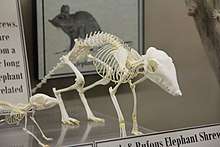
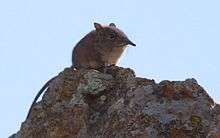
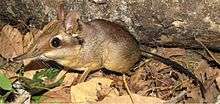
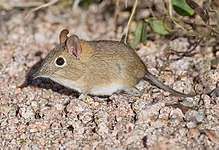

| Elephant shrew[1] | |
|---|---|
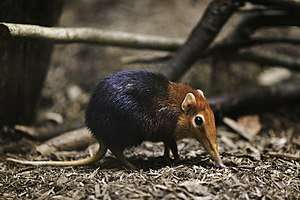 | |
| Black and rufous elephant shrew, Rhynchocyon petersi, Philadelphia Zoo | |
| Scientific classification | |
| Kingdom: | Animalia |
| Phylum: | Chordata |
| Class: | Mammalia |
| Subclass: | Theria |
| Clade: | Eutheria |
| Infraclass: | Placentalia |
| Superorder: | Afrotheria |
| Order: | Macroscelidea Butler, 1956 |
| Family: | Macroscelididae Bonaparte, 1838 |
| Genera | |
|
Elephantulus | |
They are widely distributed across the southern part of Africa, and although common nowhere, can be found in almost any type of habitat, from the Namib Desert to boulder-strewn outcrops in South Africa to thick forest. One species, the North African elephant shrew, remains in the semiarid, mountainous country in the far northwest of the continent. The Somali elephant shrew went missing from 1968 to 2020 but was rediscovered by a group of scientists in Djibouti.[6]
The creature is one of the fastest small mammals, having been recorded to reach speeds of 28.8 kilometres per hour (17.9 mph).[7] Compared to other mammalian insectivores, sengis have relatively large brains.[8]
Characteristics
Elephant shrews are small, quadrupedal, insectivorous mammals resembling rodents or opossums, with scaly tails, long snouts, and legs quite long for their size, which are used to move from one place to another like rabbits. They vary in size from about 10 to 30 centimetres (3.9 to 11.8 in), from 50 to 500 grams (1.8 to 17.6 oz). The short-eared elephant shrew has an average size of 150 mm (5.9 in). Although the size of the trunk varies among species, all are able to twist it about in search of food. Their lifespans are about two and a half to four years in the wild.[9] They have large canine teeth, and also high-crowned cheek teeth similar to those of ungulates.[10] Their dental formula is 1-3.1.4.23.1.4.2-3G
Although mostly diurnal[11] and very active, they are difficult to trap and very seldom seen; elephant shrews are wary, well camouflaged, and adept at dashing away from threats. Several species make a series of cleared pathways through the undergrowth and spend their day patrolling them for insect life. If the animal is disturbed, the pathway provides an obstacle-free escape route.
Elephant shrews are not highly social animals, but many live in monogamous pairs, which share and defend their home territory, marked using scent glands.[10] Rhynchocyon species also dig small conical holes in the soil, bandicoot-style, but others may make use of natural crevices, or make leaf nests.
Short-eared elephant shrews inhabit the dry steppes and stone deserts of southwestern Africa. They can even be found in the Namib Desert, one of the driest regions of the earth. Females drive away other females, while males try to ward off other males. Although they live in pairs, the partners do not care much for each other and their sole purpose of even associating with the opposite sex is for reproduction. Social behaviors are not very common and they even have separate nests. The one or two young are well developed at birth; they are able to run within a few hours.[12]
Female elephant shrews undergo a menstrual cycle similar to that of human females and the species is one of the few nonprimate mammals to do so.[13] Elephant shrews were used in the 1940s to study the human menstruation cycle.[14] The elephant shrew mating period lasts for several days. After mating, the pair will return to their solitary habits. After a gestation period varying from 45 to 60 days, the female will bear litters of one to three young several times a year. The young are born relatively well developed, but remain in the nest for several days before venturing outside.[10]
After five days, the young's milk diet is supplemented with mashed insects, which are collected and transported in the cheek pouches of the female. The young then slowly start to explore their environment and hunt for insects. After about 15 days, the young will begin the migratory phase of their lives, which lessens their dependency on their mother. The young will then establish their own home ranges (about 1 km2 (0.39 sq mi)) and will become sexually active within 41–46 days.[15][16]
The thermal characteristics of elephant shrews with similar body size, habitat and distribution are very close in most of the classifications. They can maintain homeothermy in different ambient temperatures where most of the species regulate their body temperature at 35 °C and neither become hyperthermic but they balance the heat offload by increasing the EWL (evaporative water loss).[17]
Feeding habits
Elephant shrews mainly eat insects, spiders, centipedes, millipedes, and earthworms. An elephant shrew uses its nose to find prey and uses its tongue to flick small food into its mouth, much like an anteater. Eating large prey can pose a challenge; an elephant shrew struggling with an earthworm must first pin its prey to the ground with a forefoot. Then, turning its head to one side, it chews pieces off with its cheek teeth, much like a dog chewing a bone. This is a sloppy process, and many small pieces of worm drop to the ground; these are simply flicked up with the tongue. Some elephant shrews also feed on small amounts of plant matter, especially new leaves, seeds, and small fruits.[15]
Evolution
A number of fossil species are known, all from Africa. They were separate from the similar-appearing order Leptictida. A considerable diversification of macroscelids occurred in the Paleogene Era. Some, such as Myohyrax, were so similar to hyraxes that they were initially included with that group, while others, such as Mylomygale, were relatively rodent-like. These unusual forms all died out by the Pleistocene.[18] Although macroscelids have been classified with many groups, often on the basis of superficial characteristics, considerable morphological and molecular evidence now indicates placing them within Afrotheria, at the base of Afroinsectivora.[19]
Classification
In the past, elephant shrews have been classified with the shrews and hedgehogs as part of the Insectivora; regarded as distant relatives of the ungulates; grouped with the treeshrews; and lumped in with the hares and rabbits in the Lagomorpha. Recent molecular evidence, however, strongly supports a superorder Afrotheria that unites elephant shrews with tenrecs and golden moles as well as certain mammals previously presumed to be ungulates, including hyraxes, sirenians, aardvarks and elephants.
| Cladogram of living elephant shrews[20][21] | |||||||||||||||||||||||||||||||||||||||||||||||||||||||||||||||||||||||||||||||||||||||||||||||||||||||||||||||
|

The 19 species of elephant shrew are placed in six genera, three of which are monotypic:
- ORDER MACROSCELIDEA[1]
- Family Macroscelididae
- Genus Elephantulus
- Short-snouted elephant shrew, E. brachyrhynchus
- Cape elephant shrew, E. edwardii
- Dusky-footed elephant shrew, E. fuscipes
- Dusky elephant shrew, E. fuscus
- Bushveld elephant shrew, E. intufi
- Eastern rock elephant shrew, E. myurus
- Karoo rock elephant shrew, E. pilicaudus[22]
- Rufous elephant shrew, E. rufescens
- Western rock elephant shrew, E. rupestris
- Genus Galegeeska
- Somali elephant shrew, G. revoilii[21]
- Genus Macroscelides
- Namib round-eared sengi, M. flavicaudatus
- Etendeka round-eared sengi, M. micus
- Round-eared elephant shrew, M. proboscideus
- Genus Petrodromus
- Four-toed elephant shrew, P. tetradactylus
- Genus Petrosaltator
- North African elephant shrew, P. rozeti
- Genus Rhynchocyon
- Golden-rumped elephant shrew, R. chrysopygus
- Checkered elephant shrew, R. cirnei
- Black and rufous elephant shrew, R. petersi
- Rhynchocyon stuhlmanni[23]
- Grey-faced sengi, R. udzungwensis
- Genus Elephantulus
- Family Macroscelididae
Notes
- Schlitter, D.A. (2005). "Order Macroscelidea". In Wilson, D.E.; Reeder, D.M (eds.). Mammal Species of the World: A Taxonomic and Geographic Reference (3rd ed.). Johns Hopkins University Press. pp. 82–85. ISBN 978-0-8018-8221-0. OCLC 62265494.
- Martin Pickford; Brigitte Senut; Helke Mocke; Cécile Mourer-Chauviré; Jean-Claude Rage; Pierre Mein (2014). "Eocene aridity in southwestern Africa: timing of onset and biological consequences". Transactions of the Royal Society of South Africa. 69 (3): 139–144. doi:10.1080/0035919X.2014.933452.
- Martin Pickford (2015). "Chrysochloridae (Mammalia) from the Lutetian (Middle Eocene) of Black Crow, Namibia" (PDF). Communications of the Geological Survey of Namibia. 16: 105–113.
- Kingdon, J. (1997). The Kingdon Field Guide to African Mammals. London: Academic Press. ISBN 978-0-691-11692-1.
- Stanhope, M. J.; Waddell, V. G.; Madsen, O.; de Jong, W.; Hedges, S. B.; Cleven, G. C.; Kao, D.; Springer, M. S. (1998). "Molecular evidence for multiple origins of Insectivora and for a new order of endemic African insectivore mammals". Proceedings of the National Academy of Sciences. 95 (17): 9967–9972. Bibcode:1998PNAS...95.9967S. doi:10.1073/pnas.95.17.9967. PMC 21445. PMID 9707584.
- Briggs, Helen (18 August 2020). "Elephant shrew rediscovered in Africa after 50 years". BBC News. Retrieved 19 August 2020.
- Nature (BBC)
- Iwaniuk, A.; Kaufman, J.A.; Turner, G.H.; Holroyd, P.A.; Rovero, F.; Grossman, A. (2013). "Brain Volume of the Newly-Discovered Species Rhynchocyon udzungwensis (Mammalia: Afrotheria: Macroscelidea): Implications for Encephalization in Sengis". PLoS ONE. 8 (3): e58667. doi:10.1371/journal.pone.0058667.
- Encyclopedia of Animals. Online database: EBSCO Publishing.
- Rathbun, Galen B. (1984). Macdonald, D. (ed.). The Encyclopedia of Mammals. New York: Facts on File. pp. 730–733. ISBN 978-0-87196-871-5.
- Conniff, Richard. Shrewd Configuration, Smithsonian, June 2005. pp. 26-28.
- "Short-eared elephant-shrew (Macroscelides proboscideus) - A "living fossil" from the Namib-desert". Natur Spot. Archived from the original on 19 July 2011. Retrieved 1 February 2010.
- van der Horst, Cornelius; Gillman, Joseph (1941). "The menstrual cycle in Elephantulus". The South African Journal of Medical Sciences. 6: 27–47.
- Carter, A.M. (2018). "Classics revisited: C. J. Van der Horst on pregnancy and menstruation in elephant shrews". Placenta. 67: 24–30. doi:10.1016/j.placenta.2018.05.010. PMID 29941170.
- Rathbun, Galen B. (September 1992). "The Fairly True Elephant-Shrew". Natural History. New York. 101.
- Unger, Regina. "Short-eared Elephant-Shrews". Retrieved 1 February 2010.
- Downs, Colleen T.; Perrin, M.R. (1995). "The thermal biology of three southern African elephant-shrews". Journal of Thermal Biology. 20 (6): 445–450. doi:10.1016/0306-4565(95)00003-F.
- Savage, RJG & Long, MR (1986). Mammal Evolution: an illustrated guide. New York: Facts on File. p. 54. ISBN 978-0-8160-1194-0.
- Tabuce, R.; Asher, R. J.; Lehmann, T. (2008). "Afrotherian mammals: a review of current data" (PDF). Mammalia. 72: 2–14. doi:10.1515/MAMM.2008.004.
- Upham, Nathan S.; Esselstyn, Jacob A.; Jetz, Walter (2019). "Inferring the mammal tree: Species-level sets of phylogenies for questions in ecology, evolution and conservation". PLoS Biol. 17 (12). doi:10.1371/journal.pbio.3000494.
- Heritage, S.; Rayaleh, H.; Awaleh, D.G.; Rathbun, G.B. (2020). "New records of a lost species and a geographic range expansion for sengis in the Horn of Africa". PeerJ. 8: e9652. doi:10.7717/peerj.9652.
- Smit, H.A.; Robinson, T.J.; Watson, J.; Jansen Van Vuuren, B. (October 2008). "A new species of elephant-shrew (Afrotheria:Macroselidea: Elephantulus) from South Africa". Journal of Mammalogy. 89 (5): 1257–1269. doi:10.1644/07-MAMM-A-254.1.
- Carlen, E.J.; Rathbun, G.B.; Olson, L.E.; Sabuni, C.A.; Stanley, W.T.; Dumbacher, J.P. (2017). "Reconstructing the molecular phylogeny of giant sengis (Macroscelidea; Macroscelididae; Rhynchocyon)". Molecular Phylogenetics and Evolution. 113: 150–160. doi:10.1016/j.ympev.2017.05.012.
References
- Murata Y, Nikaido M, Sasaki T, Cao Y, Fukumoto Y, Hasegawa M, Okada N. Afrotherian phylogeny as inferred from complete mitochondrial genomes. Mol Phylogenet Evol. 2003 Aug;28(2):253-60.
- Murphy WJ, Eizirik E, Johnson WE, Zhang YP, Ryder OA, O'Brien SJ. Molecular phylogenetics and the origins of placental mammals. Nature. 2001 February 1;409(6820):614-8.
- Tabuce R, Marivaux L, Adaci M, Bensalah M, Hartenberger JL, Mahboubi M, Mebrouk F, Tafforeau P, Jaeger JJ. Early Tertiary mammals from North Africa reinforce the molecular Afrotheria clade. Proc Biol Sci. 2007 May 7;274(1614):1159-66.
External links
- "Elephant Shrew". African Wildlife Foundation. Retrieved 1 February 2010.
- "Sengis (Elephant-Shrews)". California Academy of Sciences. Archived from the original on 10 May 2013. Retrieved 1 October 2012.
- "New Species Of Giant Elephant-shrew Discovered". Science Daily. February 2008. Retrieved 1 February 2010.
- "New sengi species is related to an elephant, but small as a mouse". Los Angeles Times. June 2014. Retrieved 1 June 2014.